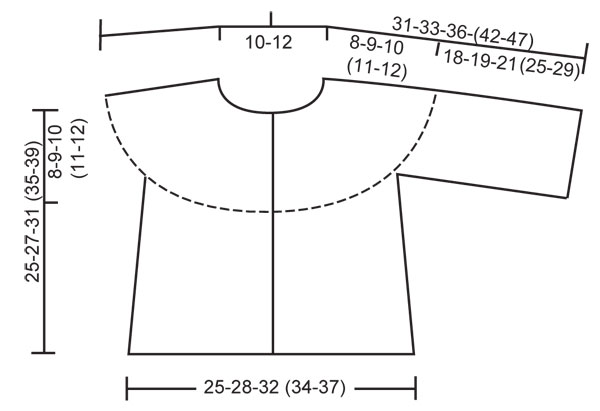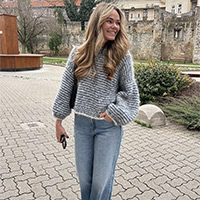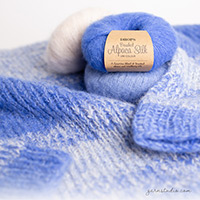Little Chestnut |
||||||||||||||||||||||||||||||||||
 |
 |
|||||||||||||||||||||||||||||||||
Set of knitted jacket with raglan sleeves, hat and booties with cables, for baby and children in DROPS Alpaca
DROPS Baby 19-17 |
||||||||||||||||||||||||||||||||||
|
GARTER ST (back and forth on needle): K all rows. GARTER ST (in the round): K 1 round, P 1 round. PATTERN: See diagram M.1 to M.4. Diagrams show the pattern from RS. BUTTONHOLES: Make buttonholes on right front band. 1 buttonhole = cast off 3rd and 4th front band st and cast on 2 new sts on return row. Make buttonholes when piece measures: SIZE 1/3 months: 4, 9, 14, 19 and 24 cm SIZE 6/9 months: 2, 8, 14, 20 and 26 cm SIZE 12/18 months: 3, 8, 14, 19, 25 and 30 cm SIZE 2 years: 4, 10, 16, 22, 28 and 34 cm SIZE 3/4 years: 3, 10, 17, 24, 31 and 38 cm -------------------------------------------------------- -------------------------------------------------------- BODY PIECE: Worked back and forth on circular needle from mid front. Cast on 139-151-170 (183-192) sts on circular needle size 2.5 mm with Alpaca. K 4 rows, AT THE SAME TIME on 4th row inc 17-19-14 (15-20) sts evenly = 156-170-184 (198-212) sts. Work next row as follows (from RS): 5 GARTER STS - see above (= front band), P2, M.1, * P6, M.3 *, repeat from *-* on the next 112-126-140 (154-168) sts, finish with P6, M.1, P2 and 5 GARTER STS (= front band). Continue in pattern like this until piece measures 7-7-7 (8-8) cm. NOTE! Remember BUTTONHOLES - see above. On next row from RS work 21 sts each side as before, K remaining sts, AT THE SAME TIME dec 9-13-8 (9-14) sts evenly on these sts = 147-157-176 (189-198) sts. On next row from WS work 21 sts each side as before, K remaining sts. Continue as follows (from RS): 5 garter sts, P2, M.1, P2, stocking st on the next 105-115-134 (147-156) sts, P2, M.1, P2 and 5 garter sts. Continue in pattern like this until piece measures 17-18-21 (24-27) cm. Work next row as follows (from RS): 21 sts as before, 14-18-24 (26-29) stocking sts (= right front piece), cast off 8 sts for armhole, 61-63-70 (79-82) stocking sts (= back piece), cast off 8 sts for armhole, 14-18-24 (26-29) stocking sts and 21 sts as before (= left front piece) = 131-141-160 (173-182) sts left on needle. Cut the thread, put piece aside and knit the sleeves. SLEEVE: Worked in the round. Cast on 36-38-40 (42-44) sts on double pointed needles size 2.5 mm with Alpaca. Insert a marker at beg of round (= mid under sleeve). Work 4 rounds GARTER ST – see above. Continue in stocking st. AT THE SAME TIME when piece measures 5 cm inc 1 st each side of marker, and repeat the inc on every 6-5-5 (6-6) round a total of 6-7-9 (10-12) times = 48-52-58 (62-68) sts. Continue until piece measures 18-19-21 (25-29) cm. Now cast off 8 sts mid under sleeve (= 4 sts each side of marker) = 40-44-50 (54-60) sts. Put piece aside and knit the other sleeve. YOKE: Slip sleeves on the same circular needle as body piece where cast off for armhole = 211-229-260 (281-302) sts. NOW MEASURE PIECE FROM HERE! On next row from WS work 21 sts each side as before, K remaining sts, AT THE SAME TIME inc 22-27-30 (33-36) sts evenly on these sts = 233-256-290 (314-338) sts. Continue as follows (as seen from RS): 5 garter st, P2, * M.1, P 11-11-12 (12-12) sts *, repeat from *-* a total of 9-10-11 (12-13) times and finish with M.1, P2 and 5 garter sts. AT THE SAME TIME dec from RS on the right and left side alternately of each P-section (dec by P2 tog, NOTE! do not dec in P2 each side) on every 1 cm a total of 6-7-8 (9-9) times. AT THE SAME TIME when piece measures 1-1-2 (3-4) cm work M.2 over all sts in M.1 (work remaining as before). After 1 vertical repeat of M.2 continue with M.3. After all dec are complete there are 139-142-154 (154-165) sts on needle. Continue until piece measures approx 7-8-9 (10-11) cm, adjust to a full vertical repeat. Now work M.4 over M.3 (work remaining sts as before) = 99-98-106 (102-109) sts. After 1 vertical repeat of M.4 K 1 row from RS on all sts, AT THE SAME TIME dec 13-10-14 (6-9) sts evenly = 86-88-92 (96-100) sts. K 1 row from WS, K 1 row from RS, K 1 row from WS and cast off loosely. ASSEMBLY: Sew openings under sleeves. Sew on buttons. -------------------------------------------------------- HAT: GARTER ST (in the round): K 1 round, P 1 round. PATTERN: See diagram M.1 to M.4. Diagrams show the pattern from RS. -------------------------------------------------------- -------------------------------------------------------- HAT: Worked in the round, from bottom up. Cast on 95-100-105 (110-120) sts on circular needle size 2.5 mm with Alpaca. Work 8 rounds GARTER ST- see above. Work next round as follows: * K1, 1 YO, K2, 1 YO, K2, 1 YO, K2, 1 YO, K1, P 11-12-13 (14-16) *, repeat from *-* a total of 5 times = 115-120-125 (130-140) sts. On next round work K over K and P over P - K all YO into back of loop to avoid a hole (= K12, P 11-12-13 (14-16)). Continue as follows: * M.1, P 11-12-13 (14-16) *, repeat from *-* a total of 5 times. REMEMBER THE KNITTING TENSION! When piece measures approx 7-8-9 (10-11) cm (adjust to a full repeat) work M.2 over M.1. NOTE! Change to double pointed needles size 2.5 mm when there are too few sts for circular needle. After 1 vertical repeat of M.2 work M.3 over M.2. AT THE SAME TIME when piece measures 10-11-12 (13-14) cm dec 2 sts in each P-section, dec by P tog the 2 first sts and P tog the 2 last sts in each P-section. Dec on every 1 cm a total of 4 times = 55-60-65 (70-80) sts. Now work M.4 over M.3 = 35-40-45 (50-60) sts. On next round K all sts, AT THE SAME TIME K2 tog across the round = 18-20-23 (25-30) sts. Cut the thread and pull it through remaining sts on needle, tighten and fasten. Hat measures approx 14-15-16 (17-18) cm. -------------------------------------------------------- BOOTIES: PATTERN: See diagram M.5. Diagram shows the pattern from RS. MOSS ST: Round 1: * K1, P1 *, repeat from *-*. Round 2: K over P and P over K. Repeat round 2. -------------------------------------------------------- -------------------------------------------------------- BOOTIE: Piece worked in the round on double pointed needles, from top down. Cast on 50-50-54 (58-62) sts on double pointed needles size 2.5 mm with Alpaca. K 1 round on all sts and continue as follows: SIZE 1/3 months + 6/9 months + 2 years: K1, * P2/K2 *, repeat from *-* on the next 16-16-20 sts, P2, M.5 (= 12 sts), * P2/K2 *, repeat from *-* on the next 16-16-20 sts, P2, K1. SIZE 12/18 months + 3/4 years: P1, * K2/P2 *, repeat from *-* on the next 20-24 sts, M.5 (= 12 sts), * P2/K2 *, repeat from *-* on the next 20-24 sts, P1. Continue like this until piece measures 6-7-7 (8-8) cm. K 1 round on all sts, AT THE SAME TIME dec 4 sts evenly on round - do not dec on the 16 sts on upper foot (= M.5 + P2 each side) = 46-46-50 (54-58) sts. Keep the 16 sts on upper foot on needle and slip remaining 30-30-34 (38-42) sts on a stitch holder. Continue in M.5 with P2 each side back and forth on needle for 3-3.5-4 (5-6) cm. On next row from RS dec 4 sts on M.5 = 12 sts left on upper foot. Now pick up 6-8-8 (10-14) sts on the side of upper foot, slip sts from stitch holder back on needle and pick up 6-8-8 (10-14) sts on the other side of upper foot = 54-58-62 (70-82) sts. Continue in MOSS ST - see above - in the round on all sts for 1.5-2-2.5 (3-3.5) cm, and now P 1 round on all sts. Cast off all sts except the 12 sts on upper foot mid front. Work 9-10-11 (13-14) cm moss st back and forth on needle on these sts for sole. Cast off and sew sole to side pieces, sew edge to edge to avoid a chunky seam. |
||||||||||||||||||||||||||||||||||
Diagram explanations |
||||||||||||||||||||||||||||||||||
|
||||||||||||||||||||||||||||||||||

|
||||||||||||||||||||||||||||||||||

|
||||||||||||||||||||||||||||||||||
|
Have you made this or any other of our designs? Tag your pictures in social media with #dropsdesign so we can see them! Do you need help with this pattern?You'll find tutorial videos, a Comments/Questions area and more by visiting the pattern on garnstudio.com. © 1982-2024 DROPS Design A/S. We reserve all rights. This document, including all its sub-sections, has copyrights. Read more about what you can do with our patterns at the bottom of each pattern on our site. |
||||||||||||||||||||||||||||||||||












































































Comments / Questions (96)
The yarn used in “Little chestnut “ is this a fingering weight?
25.06.2020 - 19:52DROPS Design answered:
Dear Mrs Rubio, this set is worked with DROPS Alpaca - click here to read more about the yarn and order. Happy knitting!
26.06.2020 - 07:35Erklären sie bitte die Abnahmen in der passe genauer, wie soll ich verstehen abwechselnd li. u re Seite wie kommen sie auf eine Abahme vom 114 Maschen Danke liebe Grüße Elisabeth Huber
16.12.2019 - 21:30DROPS Design answered:
Liebe Frau Huber, bei der 1. Abnahmen stricken Sie die 2 letzten linken Maschen zusammen, bei der nächsten Abnahmen stricken Sie die 2 ersten linken Maschen zusammen, und so wiederholen, nächstes Mal die 2 letzten (=auf der linken Seite vom li-Partien) und nächstes Mal die 2 ersten (= auf der rechten Seite vom li-Partien) usw. Nur in die 11-12 M.li-Partien abnehmen. Viel Spaß beim stricken!
17.12.2019 - 09:21Ok merci mais la première diminution vous dîtes dans les 11 mailles diminuer 2 mailles ensemble env reste 9 mailles? Après une diminution reste 10 mailles ? C’est 2 diminution par section env ?
26.10.2019 - 22:01DROPS Design answered:
Bonjour France, quand vous tricotez: 2 m ens à l'env, 9 m env = il reste 10 m envers dans la section qui en avait 11. Vous tricotez ensuite ces 10 m env ainsi: 8 m env, 2 m ens à l'env = vous tricotez 10 m env en diminuant 1 m = il reste 9 m env. et ainsi de suite. Bon tricot!
04.11.2019 - 12:19Bonjour je ne comprends pas j’ai besoin d’aide empiècement : j’ai 256 m je diminue combien de mailles dans chaque section envers et combien de section envers il y a ? Après le premier tour combien de mailles restante ?
24.10.2019 - 01:53DROPS Design answered:
Bonjour France, vous tricotez: 5 m point mousse, 2 m env, (M.1, 11 m env) x 10, M.1, 2 m env, 5 m point mousse = vous avez 10 sections de 11 m env chacune. Vous diminuez dans ces sections de 11 m env; la 1ère fois au début: 2 m ens à l'env, 9 m env, puis la fois suivante à la fin: 8 m env, 2 m ens à l'env, la 3ème fois: 2 m ens à l'env, 7 m env, la 4ème fois: 6 m env, 2 m ens à l'env et ainsi de suite jusqu'à ce qu'il reste 4 m env (vous avez diminué 7 fois 1 m env dans chaque section de 11 m env. En même temps, vous tricotez M.2 au-dessus de M.1 (= il reste 8 m dans chaque M.2), il reste 142 m au total. Bon tricot!
24.10.2019 - 10:44Meine Frage betrifft die Passe: Wo genau sind die vielen Abnahmen, wenn ich nur 8x auf der rechten und linken Voderseite abnehme (gesamt 16) und bei M2 je 4 Maschen (12x4=48 Maschen) sind insgesamt 290 - 64 = 226 . Laut Anleitung 154. Wo muss ich noch abnehmen?
10.09.2019 - 13:37DROPS Design answered:
Liebe Frau Wager, in die 3. Größe nehmen Sie nur in die 12-linke-Maschen-Partien = es sind dann 12 M - 8 = 4 linke Maschen zwischen jedem M.1 = 11 Abnahme pro Abnahmereihe - Dann nehmen Sie 4 M in jedem M.2 x 12 = 48 Abnahme - Es waren 290 M - 88 M - 48 M = 154 M. Viel Spaß beim stricken!
10.09.2019 - 14:44Hola! Creo que hay un error con los aumentos de la manga, dice que hay que aumentar 7 veces cada 5 CMS pero la manga debe medir 19 CMS. Cuántos puntos deben ser al final? para hacer mi propio cálculo, por favor. Estoy trabajando talla 6-9 meses
27.08.2019 - 07:30DROPS Design answered:
Hola Maria. El patrón está correcto. El primer aumento se trabaja a 5 cm desde el inicio. Los siguientes aumentos se repiten cada 5 VUELTAS.
31.08.2019 - 21:11Hallo, ich bin nun an der Passe, soweit alles klar aber wenn ich bei der linken Partie 11 Maschen stricken und gleichzeitig 1 Masche jeweils abnehmen soll, habe ich dann 10 Maschen weil ich Masche 10 und 11 zusammen stricke oder 11 weil ich Masche 11 und 12 zusammen stricke?
07.06.2019 - 16:46DROPS Design answered:
Liebe Claudia, wenn Sie bei der Passe abnehmen, nehmen Sie in die linken Partie ab, dh bei der 1. Abnahmen stricken Sie die 10. und 11. Linke Masche zusammen (= 10 li Maschen bleiben), bei der nächsten Abnahmen stricken Sie die 1. und 2. linke Maschen zusammen (= 9 li Maschen bleiben), bei der 3. Abnahmen stricken Sie die 8. und 9. Maschen zusammen (= 8 li Maschen) und so weiter. Viel Spaß beim stricken!
11.06.2019 - 09:30Ich bin nun in der R am Vorder-Rückenteil in der das Zopfmuster M3 wiederholt wird aber was ist mit dem ersten und letzten M1 Zopf? Laut Diagramm werden über M1 ja noch 2 Reihen mehr gestrickt bevor dieser wieder an der Reihe ist. Stricke ich da rechts/links über diese Maschen?
10.05.2019 - 17:36DROPS Design answered:
Liebe Claudia, M.3 wird über 4 Reihen wiederholt, dh wenn M.3 einmal in der Höhe gestrickt wird, wiederholen Sie das Diagram ab der 1. Reihe. Gleichzeitig stricken Sie M.1 wie im Diagram, dh über 6 Reihen = bei der 5. Reihe in M.1 stricken Sie die 1. Reihe vom 2. Rapport M.3 usw. Viel Spaß beim stricken!
13.05.2019 - 08:37Pull Lors du retour « envers » ne doit on pas tricoter les mailles comment elles se presentent Ce n’est pas mentionné ainsi mais seulement « continuer en point fantaisie » Merci
17.04.2019 - 05:01DROPS Design answered:
Bonjour Mme Alarie, vous continuez en point fantaisie ainsi avec la répartition des mailles comme indiquée, (avec les torsades de M.1) - sur l'envers, les mailles se tricotent effectivement comme elles se présentent. Bon tricot!
23.04.2019 - 11:06Buongiorno Il diagramma a rovescio,devo lavorare le maglie come si presentano? Grazie mille
14.03.2019 - 12:13DROPS Design answered:
Buongiorno Anna. Sui ferri lavorati sul rovescio del lavoro, lavora le maglie come si presentano. Buon lavoro!
14.03.2019 - 12:19